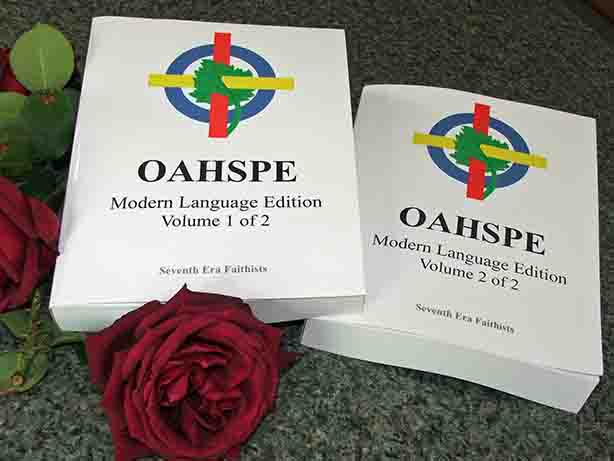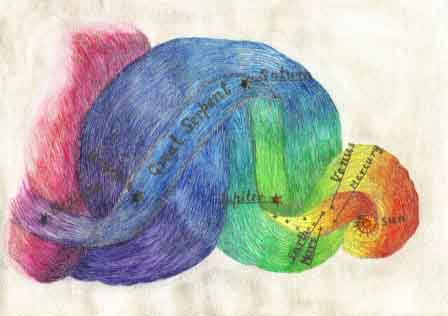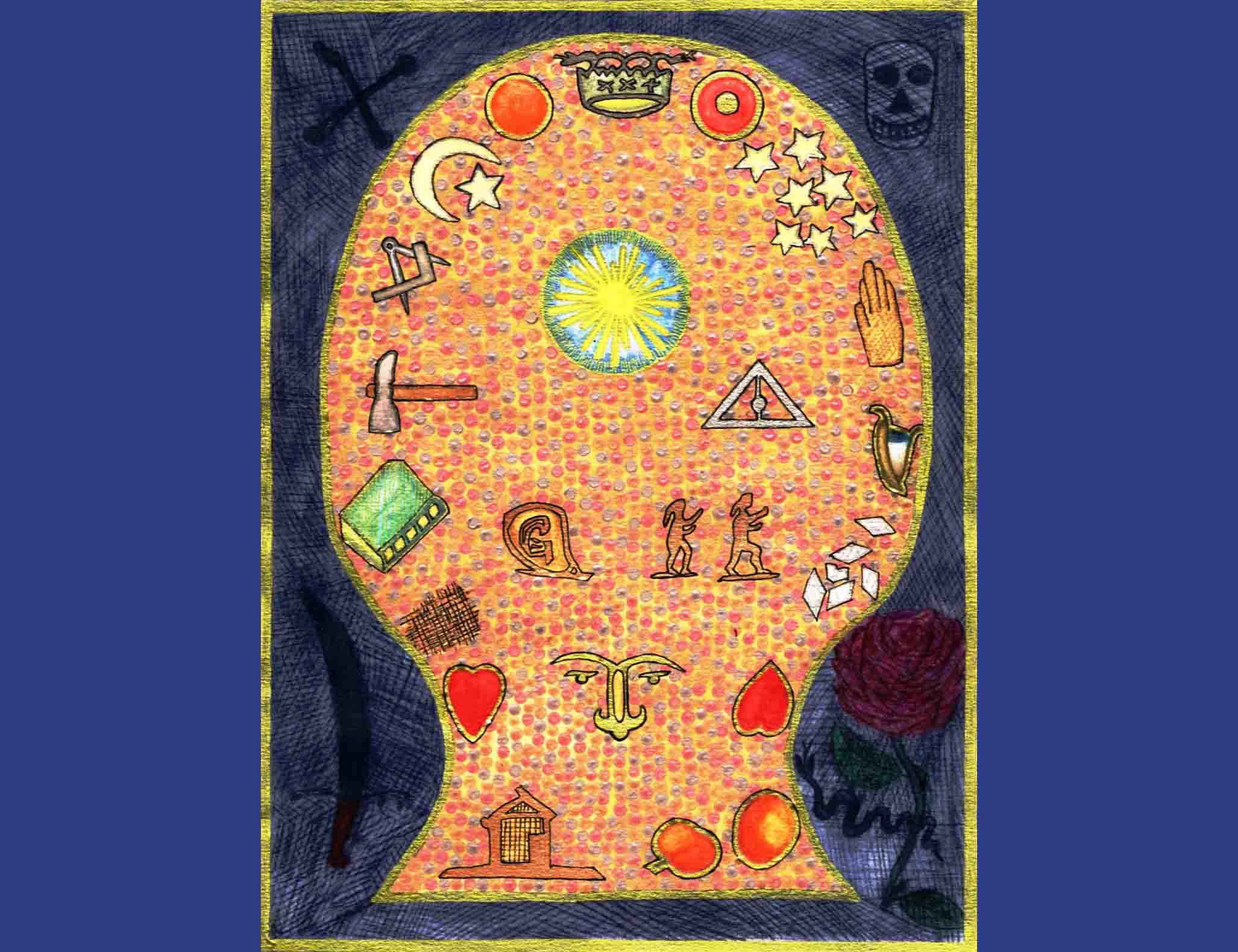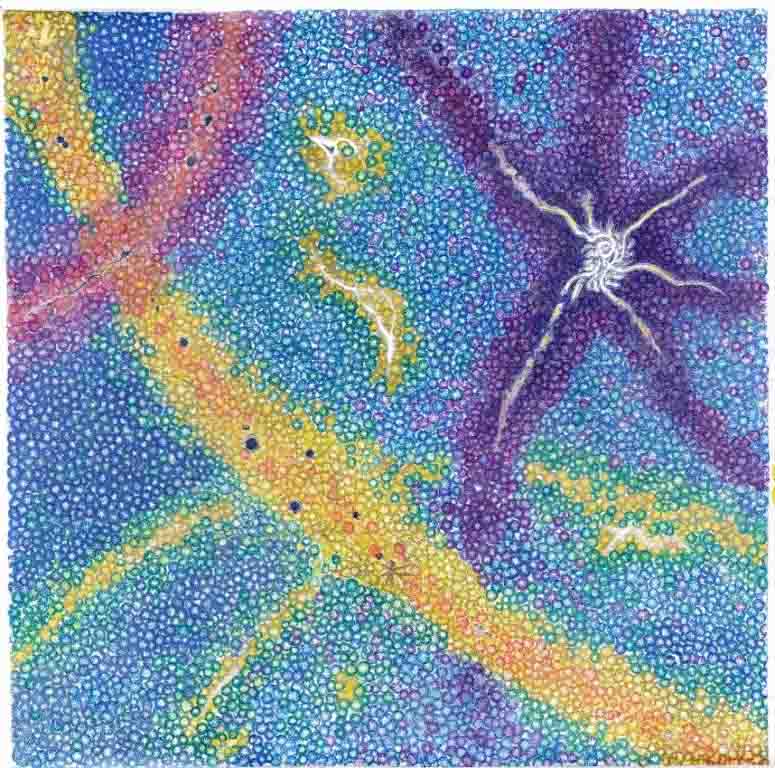John
Ballou Newbrough 1828-1891
John Newbrough was 52 years old when, through his automatic writing, Oahspe was transmitted into mortal language. This event was the significant life changing, life defining event for not only him, but many more people who would read Oahspe.
Born on June 5, 1828 in a log cabin in Mohican Township, Ohio,
John
was one of seven children whose ancestry included Scottish, Swiss and
English. Like many pioneers, John's family raised their own food and
his father was also the local schoolmaster. John also taught school
during the winter of his last year at home.
When John was
a young boy, his spiritualist mother, taught him about the communion of
angels, and John first communed with angels in the peaceful outdoors of
his family home under the great oaks and sycamores. John's father
disapproved of spirit communion but eventually became a spiritualist
when, after his wife's passing, he received messages from her.
When
he was 16, Newbrough attended High School in Cleveland, Ohio,
boarding with the family of a dentist and working as his assistant;
learning the practise of dentistry which he continued until he
graduated medical college as a physician at 21. He then worked for a
short time under the supervision of his uncle, who was the head
physician in an "insane asylum".
Newbrough's adventurous
spirit took him to the California Gold fields in 1849 where he found
gold. He shared part of his good fortune with his family back in Ohio
where his parents and younger siblings still lived. He also cared for
the sick and fevered. During his time in the gold fields, John
witnessed and deplored the injustice of bigotry, especially toward the
Chinese in the general grab for personal fortune. Here he teamed up
with, Scottish born John Turnbull, with whom he travelled to the
Australian gold fields of Ballarat, Victoria around 1851. After a
couple of more years of "living in a tent" and adding considerably to
his gold fortune, he sailed to Europe, China, India, Africa and many
far off places before returning to the U.S.
Newbrough
began practice as a physician in Cincinnati, but soon switched to
dentistry, which he practiced successfully for many years. His concern
for the needs of the suffering poor led Newbrough to develop an
inexpensive alternative rubber composition that made dentures more
accessible to the poor. The profit driven Dunlop Rubber Company
attempted court action to suppress the cheaper product but failed.
Newbrough also publish a number of his own writings, his pre-Oahspe
publications included several social commentary novels and poetry.
In
1860, Newbrough married Rachel Turnbull in her native Scotland. The
Newbroughs settled at 128 West 24th St in New York where he also
practiced dentisty until 1884. They had three children but one died in
infancy.
Newbrough's ability to see and hear spirits
and automatic writing talent; his interest and investigations into
spiritualism and mediumship; his various philanthropic activities and
social/civic reform activism; as well as generous donations to the
needy became contentious issues in his marriage. By the time he adopted
a vegan diet around 1870, he and his wife were living separate lives
under the one roof until 1884 when Newbrough departed, leaving the
residence and his thriving dental practice to his separated wife.
Newbrough was divorced in 1886 and married Frances Van De Water who was
the mother of his youngest child, Justine.
Newbrough's Life Change
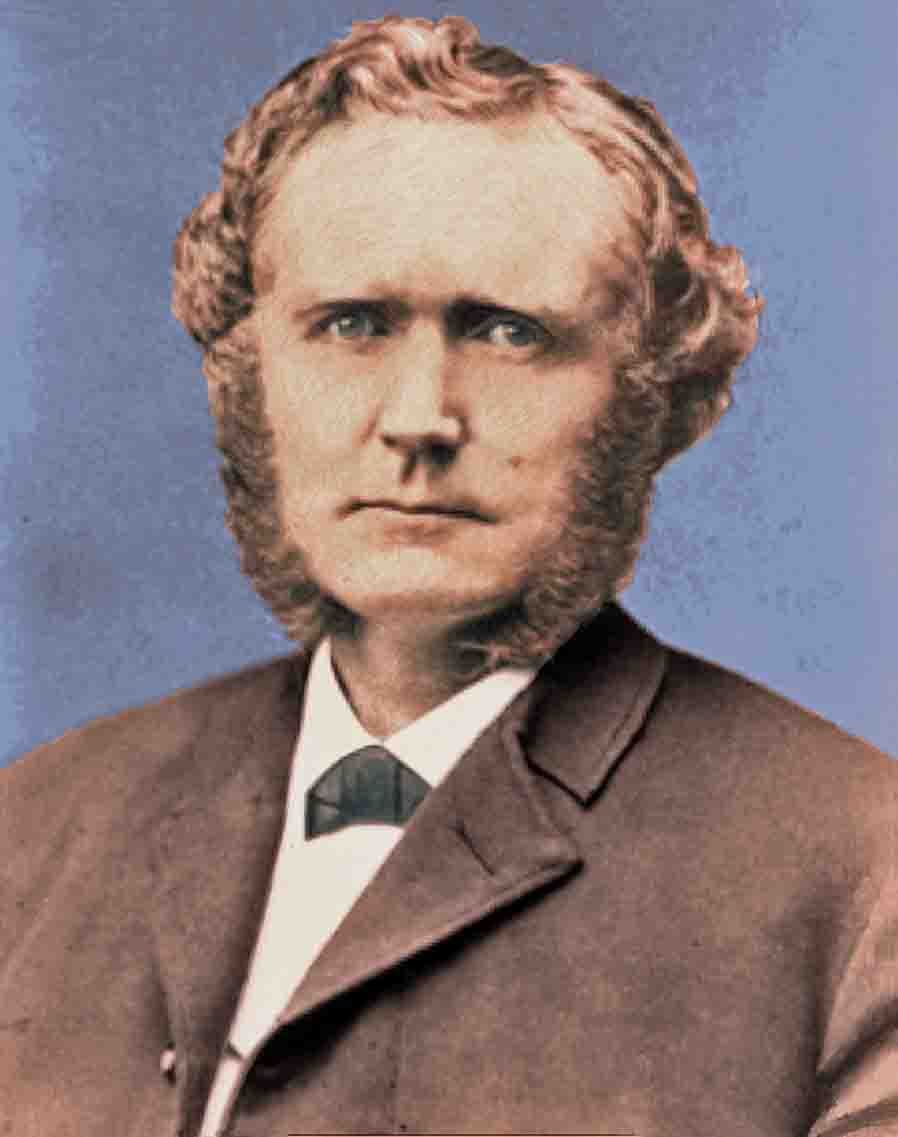 Newbrough
became vegan following a momentous angelic visitation where he was
asked if he would do a work for the Creator, to which he agreed. The
angels advised him that to prepare for such a work would take 10 years
during which time he was to adopt a vegan diet, practice clean habits
including daily bathing, introspection for self-improvement and
providing service to others regardless of profit. During that period
Newbrough published "Spiritalis" (Spirits Interviewed) in 1874.
Newbrough
became vegan following a momentous angelic visitation where he was
asked if he would do a work for the Creator, to which he agreed. The
angels advised him that to prepare for such a work would take 10 years
during which time he was to adopt a vegan diet, practice clean habits
including daily bathing, introspection for self-improvement and
providing service to others regardless of profit. During that period
Newbrough published "Spiritalis" (Spirits Interviewed) in 1874.
By
1876 Newbough's health and spiritual condition had improved so much so
that his mediumship blossomed to the extent that angels no longer held
his hands for automatic writing but over his head while a light from
above fell on his hands. He could now see the angels' materialized
hands and hear them speaking in his presence. Instructed by spirit to
buy a typewriter, Newbrough acquired the first Scholes and Glidden
typewriter in 1878. He began to practice but developed very little
typing competency.
During the following two years, the
angels had Newbrough research various scientific subjects such as
astronomy, and write down the accepted logic of the scholars in those
particular fields. The angels questioned Newbrough on these topics
systematically as he completed each subject. They informed him that
there was little or no accurate information in all the subjects
covered. Afterwards they told him that the purpose of this exercise was
to clear his mind of human fallacies so that the subject matter of the
work he was to undertake would not be influenced by his own thoughts.
It
is also likely that during these two years, there were practice
sessions on the typewriter with the angels taking control so as to
develop a clear steady connection in preparation for the transmission
of Oahspe.
One early morning (before sunrise) in the Spring
of 1880, Newbrough was sitting at his desk and the light struck both
his hands and they went for the typewriter and typed "very vigorously"
for 15 minutes. The angels told him not to read what was written. This
pattern continued every day before sunrise in 15 to 30 minute sessions
for 50 weeks. Newbrough was instructed not to read any of the typed
pages for the whole 50 weeks until the transmission was completed.
Following
an unpublished incomplete edition in 1881 (The Lant Proof Sheets),
Oahspe was published by the Oahspe Publishing Association sometime in
late September or early October, 1882 more than a year after
transmission, with 3000 copies printed.
Post Oahspe Publication and Shalam
In November 1883,
63 people gathered at Pearl River, New York, forming the "Oahspe Lodge
of Faithists". Their goal was to promote the Shalam orphanage plan.
After that Newbrough wrote "The Government and By-Laws of Faithist
Fraternities" which was somewhat modeled on Oahspe's Jehovih's
Kingdom on Earth. In that same year Newbrough and Frances Van De Water
cared for a number of infants at the Pearl River Farm.
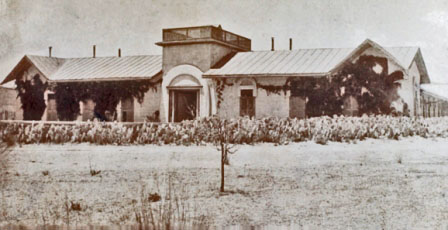
By 1884 with the financial backing of an Oahspe reader, Andrew Howland, Newbrough purchased 1,490 acres of land at Dona Ana, "on a bend of the Rio Grande" near Las Cruces, New Mexico where the Shalam Colony was to be established. In October, 1884 Newbrough and a small party of about a dozen volunteer Faithists with infant orphans took up residence at "Shalam". The members and children were strict vegetarians, although honey was included in their diet.
In March 1885, the volunteer members were informed that county deed records showed that Howland was the sole owner of the property. This caused a wave of shock and dismay for they thought Howland's financial support was donated and the property was held in common. All the volunteers, including Newbrough, who joined the colony were required to give up all possessions, giving away all they had before they could enter. Consequently, the members requested the property be transferred the resident volunteers. By December 1885 there were some 10 children and 47 members, of these there were "probabionary" members and "consecreated members". The 24 "consecrated members" became incorporated as a legal entity, "The Church of Tae", and a conditional Deed of Trust was signed between the Church of Tae and Howland. Howland became a resident of Shalam in February 1886, although he did not become a member of the Church of Tae. Shortly thereafter disagreements arose regarding the direction of the colony, and consequently Howland revoked the "Deed of Trust" and demanded payment of $37,282 for the property, which was a condition of the trust. The board of trustees of the Church of Tae returned the property to Howland in March, 1886.
Howland evicted five members and the remainder departed as well, except for Newbough and four others. Three of the evicted residents filed court proceedings for compensation but ultimately failed.
Following the evacuation of the majority of Shalam's volunteers, new members were sought, but the numbers of volunteers remained low with most of the orphan care falling to Frances Newbrough, the much loved mother figure to the children. During the trial only Howland remained at Shalam, Newbrough and the few other volunteer residents remained absent from Shalam for almost 3 years from 1887.
During their absence, Newbrough and Frances resided in New Orleans and published a monthly periodical seeking infants and volunteers for Shalam. They established a receiving home in New Orleans and a number of infants arrived in Shalam up to 1890.
In 1887 while he was in New Orleans, Newbrough wrote "Levitica", a plan for the next phase of Shalam where many of the high standards would be compromised with the expectation that more volunteers would be attracted to join. The hope was that such volunteers would eventually rise up to the standards of Shalam as expounded in Oahspe. Along this new plan, Howland had a "village" built and animal husbandry was instituted for egg and milk production. The plan however, did not produce the results that were hoped for, as few people responded but nothing came of those as to permanent membership.
In the spring of 1891, there were only two or three other volunteer members other than the Newbroughs -- a severe influenza epidemic hit the Shalam colony, when the few able adults came down with fever, there was no relief for the care of the children and sick. Newbrough, himself ill, tended to the sick, but he overcome with pneumonia and exhaustion, he passed into spirit.
When Howland was alone at Shalam from 1887, he began making notes for a new edition of Oahspe, and when Newbrough returned from New Orleans in 1889, they continued editing together until in 1891. It was when Howland was away in Boston organizing the publication of the new edition that the influenza epidemic struck the colony and Newbrough passed on April 22, just months before the second edition was published. Howland then wrote the forward to the 1891 edition which had 6000 copies printed.
The end of Shalam and the beginning of many more
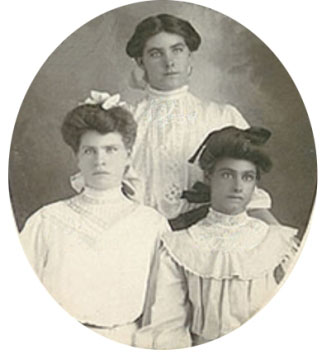
Following Newbrough's passing, Howland married his widow, Frances in 1893. In those times it was not unusual for widowed men and women to remarry because of economic necessity and to avoid the social stigma of unmarried men and women living in the same home. Howland continued to sink what was left of his fortune into building and implementing Levitica, and trying to make Shalam self sufficient with agricultural products, including cows and chickens for dairy and egg production---with little success. The spring flood of 1900 washed away the buildings and land upon which Levitica had been built. The following spring Howland received the conditional transfer deeds from Levitica and 24 children under the age of 14 were sent away to various homes and orphanages. In November 1907, after exhausting his $400,000 plus fortune, Howland and his family left Shalam and settled in El Paso, Texas.
Three Shalam children who went with the Howlands to El Paso, Texas. From left to right: Havralo (Ral), Nin'ya (Nin), Fiatisi (Fifi).
During the existence of Shalam, Lodges of Faithists continued to meet in most of the large cities of the U.S. forming what was called the "Outer Council". Part of their function was to provide support to Shalam. Each lodge was independent with its own Chief with meetings and records. After Shalam stopped receiving orphans in 1901 the Denver, Colorado Lodge which formed in 1898 and incorporated as "The Brotherhood of Light", acquired land and adopted children in Colorado and later in California. They considered themselves as the third attempt to found the Fathers' Kingdom on Earth, the first being Shalam and the second being Levitica. After the first three attempts, other attempts were made to create a Shalam colony, one well known being Wing Anderson's "Essenes of Kosmon" in Utah and then later Colorado for a few decades starting in the late 1930's.
